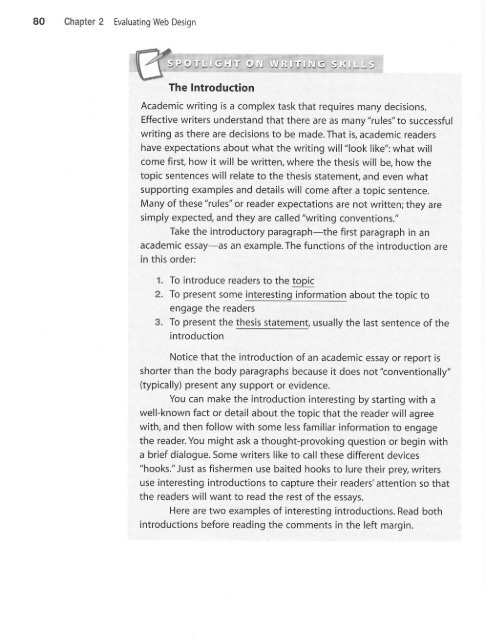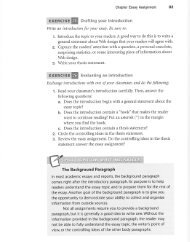College Writing 3-1
Create successful ePaper yourself
Turn your PDF publications into a flip-book with our unique Google optimized e-Paper software.
80 Chapter 2 Evaluating Web Design<br />
The lntroduction<br />
Academic writing is a complex task that requires many decisions.<br />
Effective writers understand that there are as many"rules"to successful<br />
writing as there are decisions to be made.That is, academic readers<br />
have expectations about what the writing will "look like":what will<br />
come first, how it will be written, where the thesis will be, how the<br />
topic sentences will relate to the thesis statement, and even what<br />
supporting examples and details will come after a topic sentence.<br />
Many of these "rules" or reader expectations are not written; they are<br />
simply expected, and they are called "writing conventions."<br />
Take the introductory paragraph-the first paragraph in an<br />
academic essay-as an example.The functions of the introduction are<br />
in this order:<br />
1. To introduce readers to the topic<br />
2. To present some interesting information about the topic to<br />
engage the readers<br />
3. To present the thesis statement, usually the last sentence of the<br />
introduction<br />
Notice that the introduction of an academic essay or report is<br />
shorter than the body paragraphs because it does not'tonventionally"<br />
(typically) present any support or evidence.<br />
You can make the introduction interesting by starting with a<br />
well-known fact or detail about the topic that the reader will agree<br />
with, and then follow with some less familiar information to engage<br />
the reader.You might ask a thought-provoking question or begin with<br />
a brief dialogue. Some writers like to call these different devices<br />
"hooks." Just as fishermen use baited hooks to lure their prey, writers<br />
use interesting introductions to capture their readers'attention so that<br />
the readers will want to read the rest of the essays.<br />
Here are two examples of interesting introductions. Read both<br />
introductions before reading the comments in the left margin.




